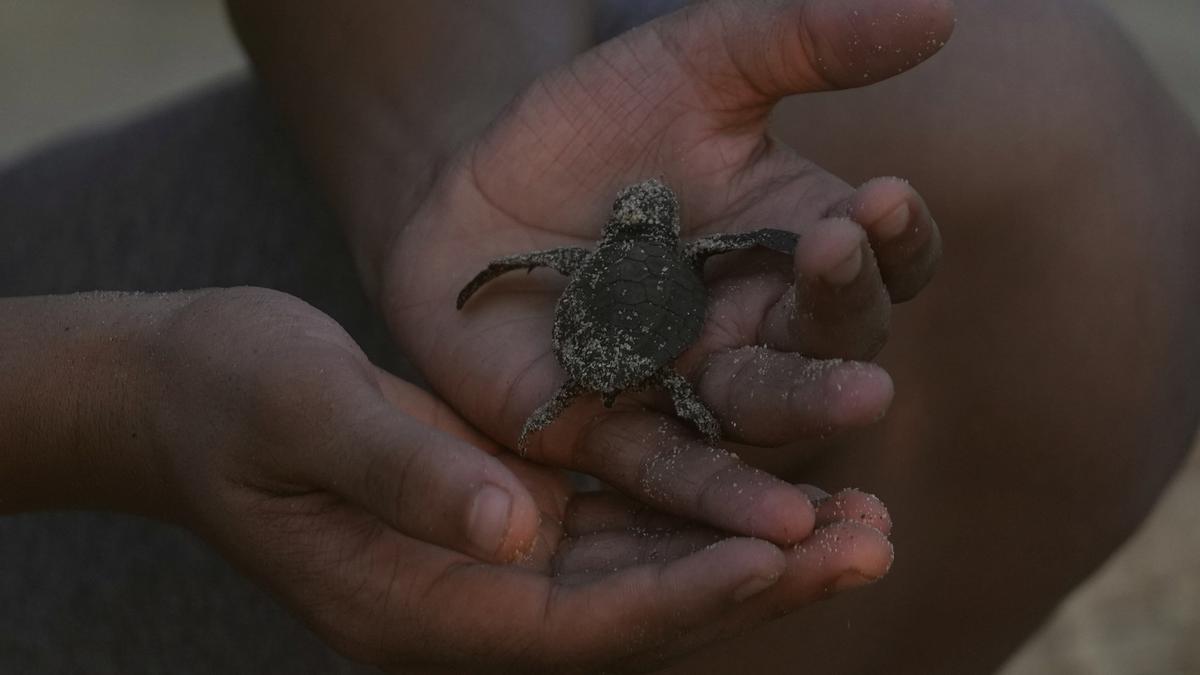An Olive Ridley turtle hatchling. File
| Photo Credit: AP
Rise in temperature has impacted sex ratio of endangered Olive Ridley sea turtles with a higher number of female turtles being found at Rushikulya River mouth in Odisha’ Ganjam district, says a study based on over 15 years of monitoring the mass nesting of the sea creatures.
The study titled ‘Monitoring sea turtles in India 2008-2024’ says, “Over the last 15 years, we have been monitoring nest temperatures and hatchling sex ratios at the Rushikulya rookery. Determining the hatchlings’ sex through gonad histology helps monitor the primary sex ratios of both solitary and arribada nests.”
Ridley turtles are famous for their unique synchronised mass nesting strategy called arribada (meaning ‘arrival’ in Spanish).
During these mass nesting events, hundreds of thousands of female turtles nest together on a beach within just a few days. Large Olive Ridley arribadas occur only in Central America and on the East coast of India. The East coast population of Olive Ridleys in India is especially interesting as it is considered to be genetically distinct and the ancestral source of Olive Ridleys around the globe, the study says. Odisha is home to two of the largest mass nesting sites – Gahirmatha and Rushikulya.
“This data has been instrumental in establishing the pivotal temperature of the population. Sex ratios at Rushikulya are skewed towards females but not to the extent seen in certain global sea turtle populations,” it says.
The study says estimating the sex ratios of hatchlings produced at this rookery was useful for understanding the future impacts of climate warming. It says as global temperatures rise, sea turtle populations might become increasingly feminised.
“The hatchling sex ratio from arribadas at Rushikulya was found to be about 71% female on average. While some years had extremely female-biased sex ratios due to high nest temperatures, a few years produced male-biased sex ratios,” the study finds.
“Our ability to accurately determine sex ratios is limited by the kind of data we can collect at the rookery. Nevertheless, with additional temperature data, we aim to employ embryo growth models to examine the long-term trends in sex ratios of hatchlings from arribadas at Rushikulya,” the study observes.
Since 2008, Dakshin Foundation and the Centre for Ecological Sciences, Indian Institute of Science, Bangalore, in collaboration with the State Forest Department have monitored Olive Ridley turtles in Odisha.
“Long-term monitoring and data generated from it can be used to understand trends in populations and predict the future impacts of climate change. They can also guide policy and determine conservation actions. In particular, they can help devise strategies that are inclusive of local communities towards long term benefits for turtles, ecosystems and people,” said Kartik Shanker, one of India’s foremost researchers on Olive Ridley turtles.
Since 2008, mass nesting events have occurred almost every year at Rushikulya in the range of between one and two lakh turtles being recorded in many years. This suggests that the Ridley population in this region is either stable or increasing. However, the mean incubation temperatures of the nests often exceeded pivotal temperatures, thereby resulting in female-biased hatchling sex ratios in some years.
Published – April 10, 2025 09:27 am IST
